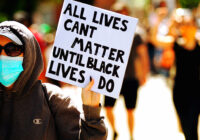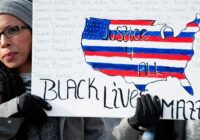In this edition of The Interview, Fair Observer talks to Akil Houston, an associate professor of African-American studies at Ohio University.
Anti-black racism in the United States continues to be a problem over half a century since the abolition of Jim Crow laws. These laws enforced segregation between black and white Americans in public places.
Although the Civil Rights Act of 1964 outlawed discrimination in employment and banned race-based segregation, as well as sporadic efforts by successive US governments to tackle racial inequalities, racism still looms large in 21st-century America.
Even if it is not a national trend, minorities in the US continue to receive discriminatory treatment from law enforcement officials and face major obstacles in securing housing, health care and quality education, as well as experiencing irregularities in the justice system. To make matters worse, things have escalated under President Donald Trump.
Some scholars talk about the existence of structural racism in the US, and there are statistics that corroborate this. In 2018, a poll by NBC News/SurveyMonkey found that a majority of Americans believe racism is a major issue in the United States. According to the poll, 64% said “racism remains a major problem” in society. This is while 45% of Americans believe race relations are getting worse.
In 2017, a poll by Quinnipiac University scholars found that more than six in 10 Americans say the “level of hatred and prejudice in the United States has increased since Trump was elected president.”
In this edition of The Interview, Fair Observer talks to Akil Houston, a filmmaker, social critic and an associate professor of cultural and media studies at Ohio University, about racial inequality, the politics of race and the portrayal of African-Americans in the media.
The transcript has been edited for clarity.
Kourosh Ziabari: The election of Barack Obama as the president of the United States in November 2008 was a turning point for the nation and for African-Americans. How do you evaluate his performance in terms of challenging and bridging the divide between black Americans and the rest of society?
Akil Houston: I don’t wholeheartedly agree with the premise of this question. Symbolically, sure. The election of Barack Obama did not change the material conditions for black America. Yes, his election was inspirational, for US citizens who longed for evidence to support their belief in meritocracy or for those who misguidedly felt his win signaled the dawning of a post-racial country.
The Obama presidency was not remarkably different than any other concerning key issues impacting African Americans. I would argue — as others have — it would be, and was in some instances, more damaging to have a black man speaking from the platform of the presidency reinforcing the myth that racial inequality in the United States is the burden of black America — the question also gestures toward this.
In a 2016 interview with The Atlantic, Barack Obama highlighted what would be a common theme in his approach to race when he said:
“[A]s a general matter, my view would be that if you want to get at African American poverty, the income gap, wealth gap, achievement gap, that the most important thing is to make sure that the society as a whole does right by people who are poor, are working class, are aspiring to a better life for their kids. Higher minimum wages, full-employment programs, early-childhood education: Those kinds of programs are, by design, universal, but by definition, because they are helping folks who are in the worst economic situations, are most likely to disproportionately impact and benefit African Americans.”
This perspective does not focus on racism as the key factor in the divide, nor does it offer any specific remedies for black America. In fact, as many historians, journalists and those from the “alternative” or “radical left” and progressive camps argued, conditions worsened during his presidency. While the obstructionist role Republicans took during his tenure cannot be undervalued, the administration took a position of non-position on racial matters.
Ziabari: President Donald Trump is openly called a racist by many of his detractors, including journalists and academics. His views on minorities and immigrants are well known to those who follow US politics. Has life become particularly difficult for African-Americans under President Trump in terms of opportunities and civil liberties?
Houston: While the current administration’s use of dog-whistle tactics may create the impression that these are recent trends, anti-black resentment has been rising since the Obama White House years. Acts of terror, from church shootings, instances of police brutality and the deaths of people like Tamir Rice, Tanisha Anderson, Sandra Bland and far too many more, demonstrate that living while black continues to be challenging regardless of who sits in the White House.
Long before this administration, there has been a historical pattern of intense resistance to African-American enfranchisement. This racial resentment typically peaks after periods of significant inclusion efforts, for instance, in response to reconstruction in the 1860s, the human rights movements of the 1950s and 1960s and most recently as a response to the presidency of Barack Obama in 2009. This political moment is consistent with this historical pattern.
Ziabari: One of the major grievances of black Americans about how they are treated pertains to the law enforcement and the justice system in the United States. It’s said that African-American wrongdoers and felons receive harsher sentences than white Americans when they commit the same crimes. Is this assertion demonstrable by facts and figures?
Houston: Yes. The book Slavery By Another Name by Douglas A. Blackmon, The New Jim Crow by Michelle Alexander and perhaps more reader friendly for a lay audience is the book Just Mercy by Bryan Stevenson. These books are a small sampling of the many books, peer-review scholarship that provides history, context and empirical data regarding incarceration, sentencing and the historic disparity within the US justice system.
Ziabari: How are black Americans depicted in mainstream media in the United States? Is the portrayal realistic, fair and objective?
Houston: This is a broad question and there are a number of variables to consider. For instance, things like overall representation, context of representation and in what forms, must be taken into account. While there are more images of African-Americans than in previous eras, African-Americans continue to be underrepresented as subject area experts — outside of sports and race — in broadcast news content and overrepresented in comedies, sports and reality-TV programming.
Ziabari: Some scholars argue that the decline in incomes and socioeconomic inequality that black and brown Americans experience today mean nothing has changed and improved significantly for African-Americans five decades after the abolition of Jim Crow laws. Do you agree?
Houston: Empirical data supports this statement. While I wouldn’t paint the African-American experience with a broad generalized brush, or state nothing has changed at all, there are still significant gaps between various groups based on race and gender. The National Urban League’s State of Black America annual report noted in 2017 that fewer black Americans are dropping out of high school and more are earning associate’s degrees. However, racial disparities still plague other areas of life.
Ziabari: An article in the American Journal of Public Health in 2004 noted that over 886,000 lives could have been saved if black Americans received the same care as whites. This is in reference to the number of African-Americans who died between 1991 to 2000 due to the lack of medical insurance, inadequate insurance, poor service and other factors. Is discrimination against African-Americans in the health sector so serious today?
Houston: I would preface my response by first saying: It is essential to be mindful that anti-discrimination laws do not operate exclusively on behalf of black people. While the adage that if white America has a cough, black America has the flu rings true, these disparities in health care impact the entire nation. Health care is as much a class issue as it is a race issue. The continuing debate on affordable health care and how the government will address treatment for pre-existing conditions and infant mortality rates in the African-American and Latino communities, coupled with the fact that people of color often complain that their physicians do not listen or misdiagnose them, provide ample evidence that these factors are present today.
Ziabari: How are African-American artists using arts and culture to reflect on the discrimination and inequalities they face today?
Houston: When I see this question, I wonder why it is posed as if it is the sole province of marginalized groups like African-Americans. Most often these same questions are not raised with white artists and their work and how it reflects on the discrimination and inequalities of society.
 As the scholar bell hooks once pointed out, ironically, more than any other group, white artists are able to produce cultural products like film and music without being subjected to a constant demand that their work engage or challenge systems of domination based on race, class and gender. As a result, it is often these works that are the most problematic. Yes, there are some artists who engage these issues as there have always been. Artists continue to engage the complexities of life. Regardless if it is the work of playwright Suzan Lori Parks, conceptual artist Hank Willis Thomas, or singer and actress Janelle Monae, artists continue to push the boundaries of creativity by exploring these issues of the day.
As the scholar bell hooks once pointed out, ironically, more than any other group, white artists are able to produce cultural products like film and music without being subjected to a constant demand that their work engage or challenge systems of domination based on race, class and gender. As a result, it is often these works that are the most problematic. Yes, there are some artists who engage these issues as there have always been. Artists continue to engage the complexities of life. Regardless if it is the work of playwright Suzan Lori Parks, conceptual artist Hank Willis Thomas, or singer and actress Janelle Monae, artists continue to push the boundaries of creativity by exploring these issues of the day.
Ziabari: How do you think African-Americans can debunk the myths about their community and enjoy greater social, economic and educational opportunities? Is it through political activism that they should overcome discrimination and difficulties?
Houston: This question assumes that some act or role by African-Americans is the salve to the nation’s centuries-old racial quagmire and doesn’t address the centrality of American racism in explaining sustained black-white disparity. Throughout US history, African-Americans have attempted all matters of redress, from enlisting in the armed services, the ballot, respectability politics, civil disobedience and other forms of dissent. From the nadir of the Civil War to the present, this has been consistent for African-American activists and their allies.
In 1968, the late writer James Baldwin was asked a similar question by Esquire magazine. His response was that, if “the American black man [and women too] is going to become a free person in this country, the people of this country have to give up something. If they don’t give it up, it will be taken from them.” I would argue that the “give up” portion has to do with the assumption that the promise of a just and truly democratic society is the responsibility of the marginalized. As Baldwin cautioned then, and I would echo now the responsibility is in large measure on white citizens who can influence the national conversation and the behavior of their families and friends in ways that marginalized groups cannot.
Ziabari: As a university professor, do you think black students feel unrestricted and also enthusiastic about engaging and interacting with students of other races, especially white students, or do racial gaps keep them apart and make their collaboration challenging?
Houston: Given the racial climate in the United States, one would be hard-pressed to find black students who didn’t feel some level of anxiety about interacting with other student populations. However, black students like other student populations are generally open to collaboration if the university is sincere in its commitment to foster an inclusive, welcoming learning environment.
Also, it is important, again, to note that black students are a diverse group. If there is a real interest in solutions, the first step is to stop thinking of black students as a monolith. These students have different worldviews, politics, goals and various identities that distinguish them from other generations of black students and each other. I would argue some faculty have these challenges around collaboration. The university campus is in many ways a microcosm of the larger US. Rather than expecting marginalized students to be the ones to shift, more progressive schools have found ways to institutionalize diversity efforts and change the way they engage these student populations.
The views expressed in this article are the author’s own and do not necessarily reflect Fair Observer’s editorial policy.
Support Fair Observer
We rely on your support for our independence, diversity and quality.
For more than 10 years, Fair Observer has been free, fair and independent. No billionaire owns us, no advertisers control us. We are a reader-supported nonprofit. Unlike many other publications, we keep our content free for readers regardless of where they live or whether they can afford to pay. We have no paywalls and no ads.
In the post-truth era of fake news, echo chambers and filter bubbles, we publish a plurality of perspectives from around the world. Anyone can publish with us, but everyone goes through a rigorous editorial process. So, you get fact-checked, well-reasoned content instead of noise.
We publish 2,500+ voices from 90+ countries. We also conduct education and training programs
on subjects ranging from digital media and journalism to writing and critical thinking. This
doesn’t come cheap. Servers, editors, trainers and web developers cost
money.
Please consider supporting us on a regular basis as a recurring donor or a
sustaining member.
Will you support FO’s journalism?
We rely on your support for our independence, diversity and quality.






